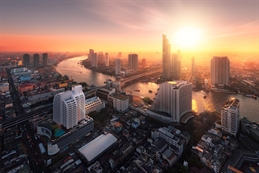
Infrastructure development in Thailand is proceeding, albeit with some concerns and problems being expressed.
Two things are noticeable. One is the sheer range of what is being planned for the Southeast Asian country and that these plans are in marked contrast to its turbulent politics.
Most recent was a late-May announcement on a fine-tuning of the facilities at gateway port Laem Chabang when Thailand’s cabinet approved a harbour development project, the government website reported after the cabinet meeting.
This will see the Port Authority of Thailand (PAT) build an L-shape harbour 30 metres wide and 120 to 125 meters in length, with a marina 115 metres x 120 metres and with a mean sea level of 10 metres.
“The harbour will support one vessel with tonnage capacity of 3,000 DWT carrying 200 DWT containers, and one with tonnage capacity of 1,000 DWT carrying 100 DWT containers. A shore crane and a container arranging crane will be installed to support up to 300,000 TEU containers per year,” the website said.
“PAT will invest in infrastructure construction and all main handling equipment, as well as management and operation with the total investment budget of B1.86 billion (US$54.8 million),” it added.
The same cabinet meeting also gave permission for minimum charges of B1,545 (US$45.50) and maximum charges of B3,180 (US$93.70). (Thailand may have fascinating up-and-down politics, but it doesn’t forget the bill.)
Of these, the minimum is a lift on/lift off charge of B715 (US$21) per container of all sizes and conditions, and a movement charge of B830 (US24.50) per container, while the maximum consists of the advanced rate of lift on/lift off fee of B2,010 (US$59.20) and a movement charge of B1,170 (US$34.50) per container.
While the new harbour at Laem Chabang is an addendum to an already up-and-running, large facility, the real action in the coming years is not so much in ports and harbours but in rail.
“Our transportation mode is unbalanced; we use the road too much,” Pichet Kunadhamraks, a senior engineer in Thailand’s Ministry of Transport, said in Bangkok at a meeting attended by Asia Cargo News. The government’s goal is to increase the proportion of freight moved by rail from 1.5% of the total to 5%, he added.
The government has wasted no time and brought in the heavy-hitters of rail by signing a Memorandum of Understanding (MoU) with the Japanese government.
The MoU is wide ranging, covering nine areas, including high speed rail.
For cargo, though, the kicker is in plans to look at a dual track or electrical train for the important Southern Economic Corridor between Kanchanaburi and Bangkok, with one spur onwards to Aranyaprathet on the Cambodian border and a second to Laem Chabang.
“This is really important for Japanese industry. They have so many distribution centres (there),” said Pichet of the routes. One of the most common criticisms of Thailand’s infrastructure is not ports nor airports, but the lack of connectivity between ports and airports. That is now firmly on the agenda and is being addressed.
Bolder still is the plan confirmed by a government spokesman that a feasibility study was also to be done for the Mae Sot to Mukdahan rail link, effectively creating a Northern Economic Corridor. That plan is very much about regional linkages, but the linkages it creates across Thailand is also a very big first.
The MoU listed three other areas which were not elaborated upon: technical assistance, a joint committee and the timeframe for implementation.
Grand though these plans are – and grander still things would be if they work out – some questions do linger.
Topping the list of questions is money. Pichet listed several different sources of funding, including the annual budget, government enterprises, public-private partnerships and infrastructure funds. There must be, he noted, many different sources of funding for projects that have huge – almost ravenous – demands, and those sources still might not be enough, especially with tight timeframes.
But the main issue is not funding, but political will, says Ruth Banomyong, head of the Department of International Business, Logistics and Transport at Thammasat Business School in Bangkok. Thailand is committed to modal shift, but the committment is not reflected in the annual government budget, he said. “A majority [of the budget] still goes to road.”
Behind this, some other issues lurk.
“We must not forget about the service level. The focus is very much on the infrastructure [but] we must not forget the software,” said Banomyong.
There is a twist here. Rail in Thailand has usually been run by the much-troubled State Railway of Thailand (SRT). That will have to end “for sure,” Pichet said. But this makes the point that Thailand’s job is not just building a railway, but also finding a way to manage it – and do so better than SRT ever did.
Another issue Banomyong raises is more pertinent still: “What kind of goods are going to go through? What is going to drive demand?” As some economists point out, Thailand has long-relied on commodities such as rice and rubber, reflecting Thailand’s basis as a rural society, but the future role of those commodities as the country’s economy develops remains unclear.
By Michael Mackey
Southeast Asia Correspondent | Bangkok



